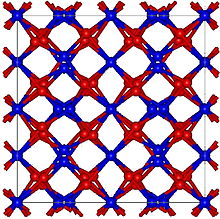
| |
| Identifiers | |
|---|---|
| CAS Number | |
| 3D model (JSmol) | |
| ECHA InfoCard | 100.013.826 |
| EC Number |
|
| PubChem CID | |
| UNII | |
| CompTox Dashboard (EPA) | |
InChI
| |
SMILES
| |
| Properties | |
| Chemical formula | Zn3N2 |
| Molar mass | 224.154 g/mol |
| Appearance | blue-gray cubic crystals |
| Density | 6.22 g/cm, solid |
| Melting point | decomposes 700°C |
| Solubility in water | insoluble, reacts |
| Structure | |
| Crystal structure | Cubic, cI80 |
| Space group | Ia-3, No. 206 |
| Hazards | |
| GHS labelling: | |
| Pictograms | 
|
| Signal word | Warning |
| Hazard statements | H315, H319 |
| Precautionary statements | P264, P280, P302+P352, P305+P351+P338, P321, P332+P313, P337+P313, P362 |
| NFPA 704 (fire diamond) |
 |
| Except where otherwise noted, data are given for materials in their standard state (at 25 °C , 100 kPa).
| |
Zinc nitride (Zn3N2) is an inorganic compound of zinc and nitrogen, usually obtained as (blue)grey crystals. It is a semiconductor. In pure form, it has the anti-bixbyite structure.
Chemical properties
Zinc nitride can be obtained by thermally decomposing zincamide (zinc diamine) in an anaerobic environment, at temperatures in excess of 200 °C. The by-product of the reaction is ammonia.
It can also be formed by heating zinc to 600 °C in a current of ammonia; the by-product is hydrogen gas.
The decomposition of Zinc Nitride into the elements at the same temperature is a competing reaction. At 700 °C Zinc Nitride decomposes. It has also been made by producing an electric discharge between zinc electrodes in a nitrogen atmosphere. Thin films have been produced by chemical vapour deposition of Bis(bis(trimethylsilyl)amido]zinc with ammonia gas onto silica or ZnO coated alumina at 275 to 410 °C.
The crystal structure is anti-isomorphous with Manganese(III) oxide. (bixbyite). The heat of formation is c. 24 kilocalories (100 kJ) per mol. It is a semiconductor with a reported bandgap of c. 3.2eV, however, a thin zinc nitride film prepared by electrolysis of molten salt mixture containing Li3N with a zinc electrode showed a band-gap of 1.01 eV.
Zinc nitride reacts violently with water to form ammonia and zinc oxide.
Zinc nitride reacts with lithium (produced in an electrochemical cell) by insertion. The initial reaction is the irreversible conversion into LiZn in a matrix of beta-Li3N. These products then can be converted reversibly and electrochemically into LiZnN and metallic Zn.
See also
References
- ^ CRC Handbook of Chemistry and Physics (96 ed.), §4-100 Physical Constants of Inorganic Compounds
- ^ Partin, D. E.; Williams, D. J.; O'Keeffe, M. (1997). "The Crystal Structures of Mg3N2 and Zn3N2". Journal of Solid State Chemistry. 132 (1): 56–59. Bibcode:1997JSSCh.132...56P. doi:10.1006/jssc.1997.7407.
- ^ Roscoe, H. E.; Schorlemmer, C. (1907) . A Treatise on Chemistry: Volume II, The Metals (4th ed.). London: Macmillan. pp. 650–651. Retrieved 2007-11-01.
- ^ Bloxam, C. L. (1903). Chemistry, Inorganic and Organic (9th ed.). Philadelphia: P. Blakiston's Son & Co. p. 380. Retrieved 2007-10-31.
- Lowry, M. T. (1922). Inorganic Chemistry. Macmillan. p. 872. Retrieved 2007-11-01.
- ^ Maxtead, E.B. (1921), Ammonia and the Nitrides, pp. 69–20
- ^ Mellor, J.W. (1964), A Comprehensive Treatise on Inorganic and Theoretical Chemistry, vol. 8, Part 1, pp. 160–161
- Maile, E.; Fischer, R. A. (Oct 2005), "MOCVD of the Cubic Zinc Nitride Phase, Zn3N2, Using Zn2 and Ammonia as Precursors", Chemical Vapor Deposition, 11 (10): 409–414, doi:10.1002/cvde.200506383
- Ebru, S.T.; Ramazan, E.; Hamide, K. (2007), "Structural and Optical Properties of Zinc Nitride Films Prepared by Pulsed Filtered Cathodic Vacuum Arc Deposition" (PDF), Chin. Phys. Lett., 24 (12): 3477, Bibcode:2007ChPhL..24.3477S, doi:10.1088/0256-307x/24/12/051, S2CID 123496085
- Toyoura, Kazuaki; Tsujimura, Hiroyuki; Goto, Takuya; Hachiya, Kan; Hagiwara, Rika; Ito, Yasuhiko (2005), "Optical properties of zinc nitride formed by molten salt electrochemical process", Thin Solid Films, 492 (1–2): 88–92, Bibcode:2005TSF...492...88T, doi:10.1016/j.tsf.2005.06.057
- Amatucci, G. G.; Pereira, N. (2004). "Nitride and Silicide Negative Electrodes". In Nazri, G.-A.; Pistoia, G. (eds.). Lithium Batteries: Science and Technology. Kluwer Academic Publishers. p. 256. ISBN 978-1-4020-7628-2. Retrieved 2007-11-01.
- Pereiraa, N.; Klein, L.C.; Amatuccia, G.G. (2002), "The Electrochemistry of Zn3 N 2 and LiZnN - A Lithium Reaction Mechanism for Metal Nitride Electrodes", Journal of the Electrochemical Society, 149 (3): A262, Bibcode:2002JElS..149A.262P, doi:10.1149/1.1446079
Further reading
- Futsuhara, M.; Yoshioka, K.; Takai, O. (1998). "Structural, electrical and optical properties of zinc nitride thin films prepared by reactive RF magnetron sputtering". Thin Solid Films. 322 (1): 274–281. Bibcode:1998TSF...322..274F. doi:10.1016/S0040-6090(97)00910-3.
- Lyutaya, M. D.; Bakuta, S. A. (1980). "Synthesis of the nitrides of Group II elements". Powder Metallurgy and Metal Ceramics. 19 (2): 118–122. doi:10.1007/BF00792038. S2CID 93036462.
- Wu, P.; Tiedje, T. (2016). "Molecular beam epitaxy growth and optical properties of single crystal Zn3N2 films". Semiconductor Science and Technology. 31 (10): 1–4. Bibcode:2016SeScT..31jLT01W. doi:10.1088/0268-1242/31/10/10LT01. S2CID 99713171.
External links
| Zinc compounds | |||
|---|---|---|---|
| Zinc(I) |
| ||
| Zinc(II) |
| ||
| Salts and covalent derivatives of the nitride ion | ||||||||||||||||||||||||||||||||||||||||||||||||||||||||||||||||||||||||||||||||||||||||||||||||||||||||||||||||||||||||||||||||||||||||||||||||||||||||||||||||||||
|---|---|---|---|---|---|---|---|---|---|---|---|---|---|---|---|---|---|---|---|---|---|---|---|---|---|---|---|---|---|---|---|---|---|---|---|---|---|---|---|---|---|---|---|---|---|---|---|---|---|---|---|---|---|---|---|---|---|---|---|---|---|---|---|---|---|---|---|---|---|---|---|---|---|---|---|---|---|---|---|---|---|---|---|---|---|---|---|---|---|---|---|---|---|---|---|---|---|---|---|---|---|---|---|---|---|---|---|---|---|---|---|---|---|---|---|---|---|---|---|---|---|---|---|---|---|---|---|---|---|---|---|---|---|---|---|---|---|---|---|---|---|---|---|---|---|---|---|---|---|---|---|---|---|---|---|---|---|---|---|---|---|---|---|---|
| ||||||||||||||||||||||||||||||||||||||||||||||||||||||||||||||||||||||||||||||||||||||||||||||||||||||||||||||||||||||||||||||||||||||||||||||||||||||||||||||||||||